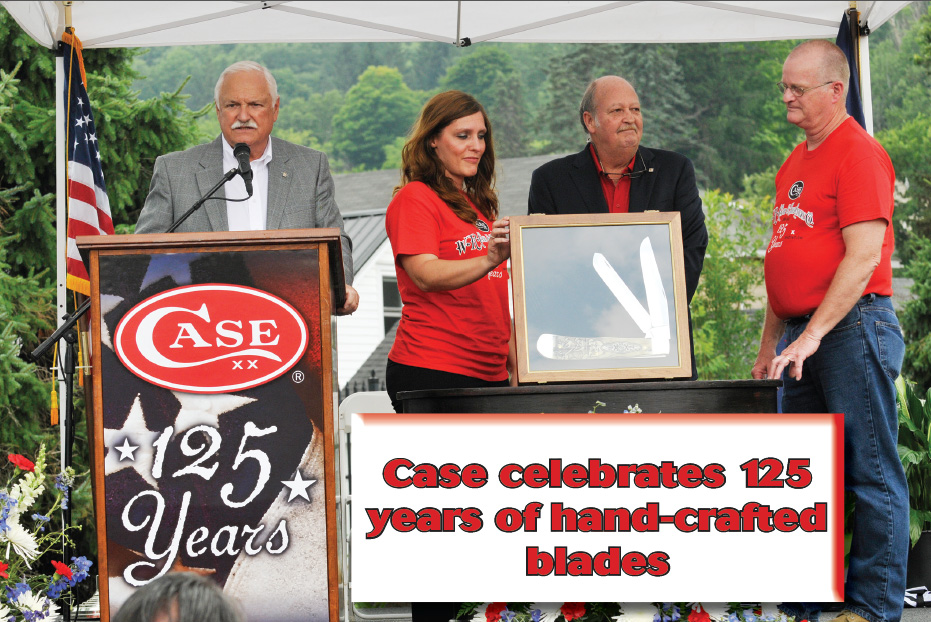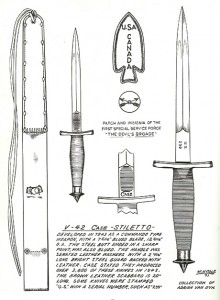 At the outdoor ceremony in the park surrounding the CaseZippo Museum in Bradford, PA, on July 23, a special large commemorative display knife for the museum, made by Mike DuBois, right, was presented to Case historian Katie Shonts Saar, while Case President Greg Booth, left, and Case-Zippo CEO George Duke, behind knife display, provide commentary.
At the outdoor ceremony in the park surrounding the CaseZippo Museum in Bradford, PA, on July 23, a special large commemorative display knife for the museum, made by Mike DuBois, right, was presented to Case historian Katie Shonts Saar, while Case President Greg Booth, left, and Case-Zippo CEO George Duke, behind knife display, provide commentary.
by Joseph P. Tartaro | Executive Editor
Back when I was in grammar school and dinosaurs still roamed the earth, school-aged boys who wore knickers could also own and wear short leather boots with a pocket on the side to carry a small folding knife. I still remember the ones I wore with a two-bladed Case folding knife. The knife was just about three inches long, the equivalent of what Case today catalogs as a Peanut or Mini-Trapper.
The boots were practical, but would probably be called “tactical” these days—almost everything else is. In the old days, you had the knife with you everywhere, including school. Alas, times have changed. They don’t make boys’ boots like that anymore, and you couldn’t wear them to school with your little folder these days or you’d be expelled.
Fortunately, you can still get Case knives like the one I owned back them, because Case is still hand-crafting folding, straight and specialty knives.

Schematic drawings of the handmade
World War II era V-42 Stiletto made for
the First Special Forces Group by W.R.
Case & Sons Cutlery Company.
When I say hand-crafted I should tell you that it takes 125 pairs of hands to make them—each little part is a separate operation, and some 160 steps are required to make one of these classic Case knives. There are a lot of great products from the past that are only available today in antique shops, and some of them may even be vintage Case blades that collector’s haven’t found yet. On the other hand, you can still buy brand new Case knives in more than 2,000 Case authorized dealers across the country, plus popular outdoor-themed chains like Cabela’s, Bass Pro, Field & Stream, Dick’s Sporting Goods, Tractor Supply Stores, Sportsman’s Warehouse, REI, Academy Sports + Outdoors and Costco; lots of sporting goods, hardware and cutlery stores, and even online through Case e-tailers, such as Amazon.com.
That’s because craftsmen and women are still hand-building those knives within a few miles of where the Case Brothers first starting making them when first they arrived in America from Sheffield, England. That’s where they first learned the cutler’s trade.
When the W.R. Case & Sons Cutlery Company celebrated the 125th anniversary of the founding of the firm on July 23 in Bradford, TGM was there. The celebration involved all of the employees of the company and its principals decked out in special 125th anniversary red T-shirts.
Under the leadership of Russell Case in 1889, four Case brothers began fashioning knives and selling them along a wagon trail in southwestern New York. Like each knife manufactured at the Case factory in Bradford, PA, the 125th landmark is a testament to the hundreds of dedicated artisans who have helped Case knives reach the moon, the White House and into the hearts of famous dignitaries, soldiers and celebrities throughout history. As an example, while in the White House, President Dwight D.
Eisenhower regularly bought Case knives to give as gifts to dignitaries and friends. Years later, Case presented a custom hunting knife to our nation’s 40th President and Case enthusiast, Ronald Reagan.
The company’s continuing commitment to American hand-crafting is part of a work ethic that resonates with the countless hard-working Americans who have made giving Case knives part of a family tradition that spans generations.
To further that commitment, Case Cutlery’s parent company, Zippo Manufacturing Company, which acquired Case in 1993, is investing nearly $10 million toward renovating their Bradford factory.
The renovations, which are currently underway and expected to finish by the end of 2015, include a complete remodeling of the Case Cutlery factory that was originally constructed in 1975, including new equipment and floor configurations that will allow better efficiency, productivity and quality without affecting the handcraftsmanship that goes into every Case knife. The company’s current location is its third manufacturing facility in Bradford since 1905.
Actually, the Case/Zippo family of business has a very large footprint in Bradford, with separate Case and Zippo factories plus a Case-Zippo Museum (CZM) on separate grounds located roughly between the two manufacturing facilities. The Museum itself is a major attraction for tourists.
The CZM gives visitors an up-todate look at more than the history of the firms and their products through Company history. It also exhibits all the latest products from Case Zippo.
That’s where TGM first learned that Zippo also now owns its one-time competing lighter brand, Ronson, into the outdoor products market.
In addition to their lanterns, hand warmers, 4-in-1 tools, and camp utensils, Zippo now has an All-Terrain Grill that folds up for transport and storage and opens up to cook food at the ruggedest campsite.
“We are very proud of what we have been able to achieve in the last 20 years by bringing these two iconic brands together,” said George Duke, CEO, Zippo/W.R. Case & Sons Cutlery Company. “With Case, our current focus is on improving efficiency, which we hope to achieve with this new investment, and drive future innovation and new product development.” Actually, the company is bullish on the outdoor industry.
Greg Booth, president of Case Cutlery, told TGM that the company is looking at the possibility of acquiring other branded lines.
With a refurbished outlook in the future, Case also looks towards an increased ability to revive classic styles and create new designs. Case is planning to roll out a World War II V-42 Stiletto reproduction model next year, an idea that’s been highly anticipated by America’s servicemen and women as well as Case collectors Case knives and the American military have gone hand-in-hand for decades, as far back as World War I, when the US government called on Case to make military knives for American servicemen and women.
In addition, Case’s future plans include working with leaders from the custom knife market like the legendary Tony Bose, who will help Case launch the 2015 Case collaborative Cattleman’s Knife.
Case has worked with Bose and other industry master craftsmen for years to offer fans, collectors and enthusiasts “closest-to-custom” knife designs they might not otherwise be able to obtain.
While new designs for everyday use and traditional favorites for outdoor enthusiasts spur its climbing sales growth, Case’s collectability, seasonal editions and licensing agreements continue to help drive year-overyear growth. Case’s collectability is attributed to the unique tang stamp dating system that was introduced during the company’s infancy. Using this system, today’s collectors can easily identify and ascertain the manufacturing date of almost any Case knife, thereby raising the knives’ intrinsic value. The brand’s popularity is further underscored by the knives it manufactures under licensing agreements with popular American icons such as Harley-Davidson®, Boy Scouts of America®, United States Marine Corps®, Ducks Unlimited®, John Deere™, John Wayne® (Wayne Enterprises) and Matt Hughes.



